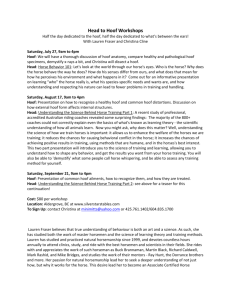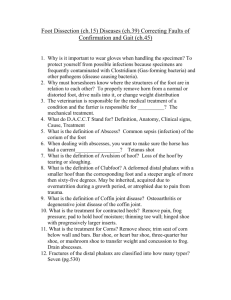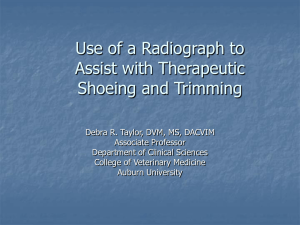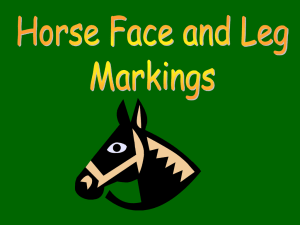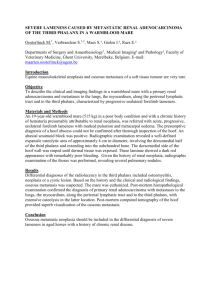Hoof Volume Displacement
advertisement
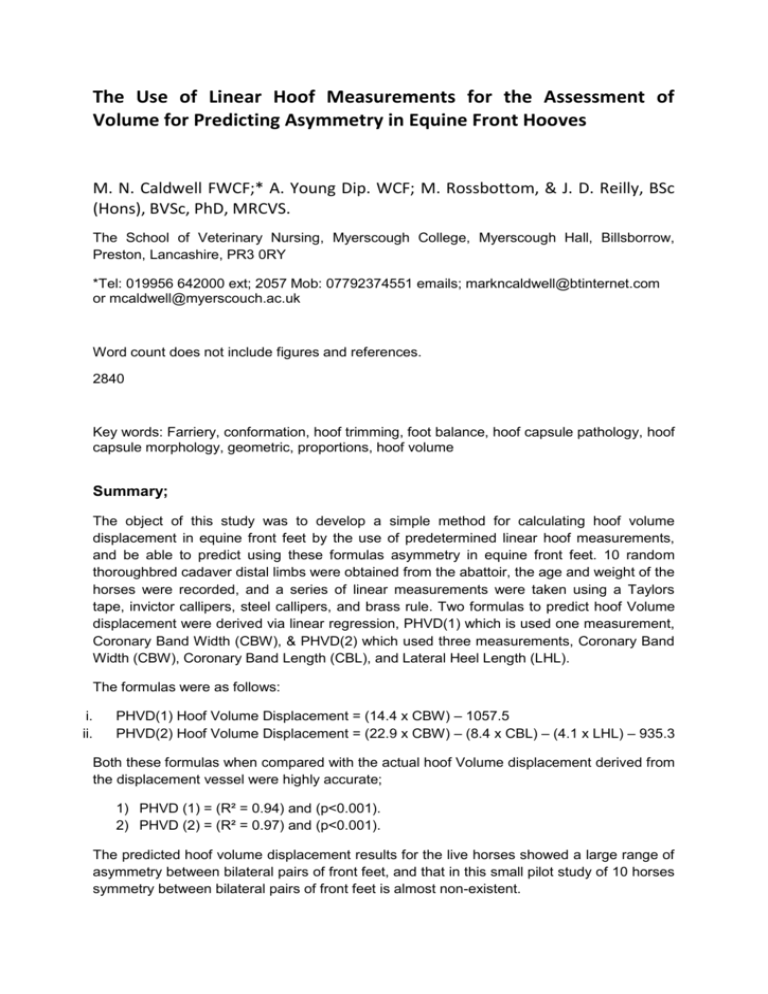
The Use of Linear Hoof Measurements for the Assessment of Volume for Predicting Asymmetry in Equine Front Hooves M. N. Caldwell FWCF;* A. Young Dip. WCF; M. Rossbottom, & J. D. Reilly, BSc (Hons), BVSc, PhD, MRCVS. The School of Veterinary Nursing, Myerscough College, Myerscough Hall, Billsborrow, Preston, Lancashire, PR3 0RY *Tel: 019956 642000 ext; 2057 Mob: 07792374551 emails; markncaldwell@btinternet.com or mcaldwell@myerscouch.ac.uk Word count does not include figures and references. 2840 Key words: Farriery, conformation, hoof trimming, foot balance, hoof capsule pathology, hoof capsule morphology, geometric, proportions, hoof volume Summary; The object of this study was to develop a simple method for calculating hoof volume displacement in equine front feet by the use of predetermined linear hoof measurements, and be able to predict using these formulas asymmetry in equine front feet. 10 random thoroughbred cadaver distal limbs were obtained from the abattoir, the age and weight of the horses were recorded, and a series of linear measurements were taken using a Taylors tape, invictor callipers, steel callipers, and brass rule. Two formulas to predict hoof Volume displacement were derived via linear regression, PHVD(1) which is used one measurement, Coronary Band Width (CBW), & PHVD(2) which used three measurements, Coronary Band Width (CBW), Coronary Band Length (CBL), and Lateral Heel Length (LHL). The formulas were as follows: i. ii. PHVD(1) Hoof Volume Displacement = (14.4 x CBW) – 1057.5 PHVD(2) Hoof Volume Displacement = (22.9 x CBW) – (8.4 x CBL) – (4.1 x LHL) – 935.3 Both these formulas when compared with the actual hoof Volume displacement derived from the displacement vessel were highly accurate; 1) PHVD (1) = (R² = 0.94) and (p<0.001). 2) PHVD (2) = (R² = 0.97) and (p<0.001). The predicted hoof volume displacement results for the live horses showed a large range of asymmetry between bilateral pairs of front feet, and that in this small pilot study of 10 horses symmetry between bilateral pairs of front feet is almost non-existent. Introduction; The Oxford English dictionary defines symmetry as “the quality of being made up of exactly similar parts facing each other or around an axis.” And asymmetry as “lack of symmetry” Asymmetrical or mismatched front hooves have been documented through history (Hunting 1895; Gonzales 1988; Butler 2005 & Caldwell et al 2010). Much has been written about ideal hoof angles yet what constitutes deal hoof shape and what is considered to be symmetrical or asymmetrical in pairs of front hooves (Russell 1897; Hickman & Humphreys 1987; Duckett 1990; Ovnicek 1995; Stashak 2002 and Butler 2005) has been a cause of debate amongst hoof care professionals for centuries. Turner & Stork (1988) suggest that opinions on what constitutes balance in the horse’s foot are largely based upon the clinician’s personal experience and how that individual evaluates a problem. The hoof varies greatly in shape even when sound and healthy (Caldwell et al 2010) and the so called balance of individual or pairs of feet is still thought to be the single most important factor in farriery. Lower limb Lameness’s and pathologies in horses has been directly related to hoof capsule abnormalities such as mismatched or asymmetrical hooves (Turner. 1988). Asymmetry is present in horse’s feet and understanding the aetiopathogenesis of hoof capsule pathologies such as sheared heels (Moyer & Anderson 1975; Turner 1992), club foot (Redden 2003) are an important component in maintaining soundness. It has also been stated that horse with hooves that are small relative to body size have been associated with increased lameness (Dyson 1995), and hoof size in horses and foot asymmetry can be a result of both genetic and environmental influences. Hoof defects may be passed on from one or both parents to a foal and are highly hereditary (Stashak 1987). Abnormalities such as asymmetrical feet can alter the anti-concussive abilities of the hoof which will in turn increase the likelihood of lameness (Turner & Stork 1988). Dollar and Wheatley (1898) noted that the ideal coronary circumference in front-feet, measured approximately 5/6 (83%) of the bearing boarder circumference. Verschooten (1992) suggests that the hoof is immeasurable due to its unique shape. Verschooten (1992) suggests foot mass is representative of the total volume of the hoof and all structures contained within it yet no formula is advocated to measure the foot volume. Floyd (2007) stresses hoof mass the importance of in healthy hooves supporting Reddens (2000) statement that small feet and their lack of hoof mass are important contributing factor to lameness. (Turner et al 1988), then states that the balance of a horse’s foot can largely be based on a person's opinion and experience, and that a system for defining hoof asymmetry that can be universally understood by all professions when conversing with each other would be good. The lack of research into the effect of uneven feet and uneven loading patterns demonstrates a need for a uniform definition of hoof asymmetry between pairs of front feet by calculating hoof volume. Phillips et al (1996) and Scott & Naylor (1999) utilised a series of simple linear measurements to formulate a regression calculation for predicting hoof volume in bovine claws. The establishment of a predictable model for hoof volume might help to develop a standardised system for predicting hoof loading and predisposed hoof pathologies linked to asymmetrical feet. Aim of Study; The aim of this study is to record a range of pre-determined linear hoof capsule measurements and hoof capsule volume displacement to; a) Produce a formula to predict hoof volume in equine front feet. b) To predict asymmetry in equine front feet by predicted hoof volume be (Hunting 1895; Lungwitz 1898; Verschooten 1992, and Turner 2006). Materials & Methods; Quantifying hoof volume; 10 random thoroughbred cadaver distal limbs from the distal carpal metacarpal joint were obtained from the abattoir. The known age and weight of the horses were recorded. The hooves were then cleaned and marked for identification purposes; each hoof was prepared by shaving the hair around the coronary band and then trimmed to a standardised trimming protocol (Caldwell et al 2010). Each hoof was trimmed by an experienced farrier familiar with the protocol and each foot was checked for consistency by two other experienced farriers. The hooves where dissected from the rest of the limb along the coronary band using a Dewalt DW738™ band saw (Fig 1). Four digital pictures of each hoof were then taken Dorsal, Solar, Lateral and an oblique transverse Coronary band view using a Fuji Finepix © mounted on a tripod to ensure consistency of photographic standards. Feet were placed in a custom made photographic box with a metric and imperial calibrating marker (fig 2). Linear measurements were taken (table 2) using a Taylors tape, invictor callipers, steel callipers, and brass rule. Measurements were recorded on two separate days by different operatives and the data compared to check the reliability and repeatability of the method (Scott, Naylor et al. 1999). Measurements from the Ontrackequine™ digital measurement software were then used to evaluate the accuracy of linear measurements taken by the operatives. The hoof measurements taken were; 1) The coronary band circumference this was taken just below the coronary hairline using Taylors tape. 2) Hoof width at the bearing border was measured at the widest point of the foot with invictor metric callipers with spirit levels to ensure accurate reading each. 3) The Coronary Band width was measured at the widest point of the coronary border using the invictor metric callipers. 4) The linear toe length was measured from the flexible junction of the coronary band midline dead centre down to the dorsodistal tip of the ground bearing border using steel dividers. Points the dividers were then placed on a ruler and measured. 5) The linear heel length was measured from the flexible junction of the coronary band to the point of heel on the ground bearing surface steel dividers. 6) The ground bearing boarder circumference was measured using Taylors tape. 7) Toe & Heel angle was measured using Ontrackequine™ digital measurement software. Farriers hoof gauges are not a reliable method to measure hoof angles (Moleman & Van Heel 2005). 8) The Bearing Boarder Length was measured down the midline that bisects the frog from the toe to the last bearing surface of the heel, using the Invictor Metric Callipers. 9) Coronary Band Length was measured down the midline of the sagittal plane from the dorsal to palmar aspect, using the Invictor Metric Callipers. Displacement Vessel Calibration; Prior to running hoof volume displacement tests the accuracy of a displacement vessel was tested by a series of calibration tests (Karges et al 2003). The displacement vessel filled with water until it overflowed. Once water stopped dripping from the spout, the vessel was then considered “topped up”. A measurement container (1000ml Azlon measurement cylinder) was placed underneath the spout. A machined steel block of known dimensions was carefully placed in the displacement vessel and the amount of spill water collected in the measurement cylinder and recorded, this procedure was repeated 10 times. In each of the 10 calibration tests the spill water collected was exactly the same as the known volume of the steel block; Steel block dimensions, 100mm x 75mm x 50mm = 3750mm³ = 375cm³ 10 calibration displacement tests, displaced volume = 375ml = 375cm³ Hoof Volume Displacement; Each hoof was then in turn immersed in the displacement vessel the displaced water was collected and measured using a 1000 mL Azlon measurement cylinder the resulting volume was then recorded. (Fig 3) This procedure of measurement and displacement was performed twice on separate days by different operatives, and the data was compared to check the accuracy and repeatability of this method. All the collected data (table 2) was analysed in Minitab 15® and the variables selected by this process were then analysed using stepwise regression to determine a formula to predict hoof volume using linear measurements. Live Horse Linear Hoof Measurements; A random sample population of ten horses (table 1) was chosen ranging in size from 14.1hh to 16.2hh and in weight from 389 Kg to 629 Kg. All were in regular riding school work and professionally managed and followed a regular shoeing cycle. The feet were thoroughly cleaned out and prepared for the experiment. Each horse was labelled for identification their gender, height, age and weight were recorded. The same bilateral linear hoof measurements (as the cadaver data) were then taken from each horse’s front feet all measurements were recorded in the results (table 3). The only changes to the measurement protocol of the cadavers were: 1) The Coronary Band width was measured below the coronary hairline at the widest point of the hoof using the invictor metric callipers. 2) Toe & heel angle was discarded on the live horses, as farrier’s hoof gauges are not a reliable method to measure hoof angles (Moleman & Van Heel 2005). 3) Toe & Heel height measurement was discarded in the live horses as they were shod and the thickness of the shoe would have made the measurements inaccurate, for the measurements to be accurate then the shoes would have had to been removed. All measurements were randomly repeated by a second person to check accuracy and repeatability; all the linear hoof measurements were then recorded onto Microsoft Office 2007® Excel™ spreadsheet for analysis (table 3). Each hoof and was digitally photographed from the lateral view and from the solar view these pictures and loaded into Ontrackequine © digital measurement software. Using coloured stickers external reference markers were placed on the foot at the intersection of the X and Y axis palmar to the apex of the frog at the widest part of the foot. Lateral view, along the Z axis intersecting at the widest point of the foot from a coloured sticker placed on the foot approximately half way along the height of lateral wall of the hoof (Figure 4). Using a Fuji Finepix © with the tripod, the crosshairs in the camera to line up with external reference points markers placed on the hoof and the picture taken using the autofocus facility. Data Analysis & Formula Prediction After all the linear hoof measurements and hoof Volume displacement measurements taken, the data was recorded on Microsoft Office 2007® Excel™ spreadsheet (table 2), the data was then transferred and analysed via stepwise linear regression using the program Mini-Tab™. Results; The results for hoof volume calculations are listed in table 2. Variable analysis produced two formulas to predict hoof Volume displacement. PHVD(1) which used one measurement, CBW and PHVD(2) which used three measurements CBW, CBL and LHL. The formulas were as follows: a. PHVD(1) Hoof Volume Displacement = (14.4 x CBW) – 1057.5 b. PHVD(2) Hoof Volume Displacement = (22.9 x CBW) – (8.4 x CBL) – (4.1 x LHL) – 935.3 These formulas were then tested against the known hoof Volume displacements derived from the displacement vessel using Excel™ (table2), linear regression was then used to test their accuracy the results were as follows; Both these linear regression results show the volume calculated from both these formulas when compared with the actual hoof Volume displacement derived from the displacement vessel to be highly accurate; PHVD (1) = (R² = 0.94) P<0.001 (Fig 4). PHVD (2) = (R² = 0.97) P<0.001 (Fig 5). Interestingly the CBW is directly proportionate to hoof Volume displacement e.g. the larger the CBW the greater the hoof Volume displacement. Once both formulas had been tested for accuracy they were then used on the live horses linear hoof measurements to test for front foot asymmetry the results are listed (table 3). The results for both predicted hoof Volume displacement formulae show some degree of asymmetry between bilateral pairs of front feet. This study indicates a CBC ratio of DFBC in the range of 78%-91% mean, 84% sd ± 3.4% (P<0.001), R²=0.726, n=52. The results (table 2) for coronary band percentage of bearing boarder circumference show the lowest percentage being 78% and the highest being 91% with an average of 84%. Discussion; We confirm that the calibration of the displacement tank (Karges et al 2003) proved it to be very accurate at calculating the amounts of water displaced being equal to the volume of the object immersed in it. The manual linear measurements taken were compared tested against measurements taken using Ontrack™ measurement software and proved to be accurate. The importance of accurate linear hoof measurement protocols must be adhered to by all operatives to ensure continued accuracy in further studies. The formula that were derived from the linear regression results showed an accuracy of 94% and 97% at predicting hoof volume (Fig’s 4 & 5), both these formulas are an easy-to-use system for measuring hoof volume in equine front feet in the field. The first formula PHVD(1) uses only one hoof measurement CBW and the equation correctly predicts 94% of the variation in hoof volume, the second formula PHVD(2) uses three hoof measurements CBW,CBL & LHL and the equation correctly predicts 97% of the variation in hoof volume. Although this study is only a pilot study of a small number of hooves results indicate that further investigation with a greater population is warranted to validate the formulae. Both formulas use the coronary band as the primary place for linear measurement this backs up previous studies into predicting hoof shape and form using coronary band measurements, (Turner 1988). (Dollar & Wheatley 1898) first used Coronary band circumference to compare foot size they stated that “in front-feet the coronary circumference is about 5/6 that of the planter” (83% of the bearing boarder circumference), interestingly this study shows a very close relationship to that with a mean of 84%, which is only 1% difference to that of Dollar & Wheatley. This study indicates Dollar & Wheatley’s (1898) assertion that a variation in CBC may prove significant in the pathogeneses of specific pathologies of the feet. Clearly more detailed analysis of CBC in feet exhibiting foot gross hoof capsule morphological variation and with known pathologies is required. (Butler 2005) talks of using the Coronary band as an area to give a good indication of the correct angle and form of a particular foot in an asymmetrical pair. This supports the use of the coronary band measurements as, an area that hasn't had any outside influences of farriery, as an indicator of the hoofs true form. One downfall of predicting hoof size using hoof volume displacement formulas are that although you can predict hoof volume accurately, the formulas are unable to predict each foots unique confirmation such as toe to heel angle ratio and its relation to the rest of the distal limb. This may well be an influencing factor on the formulas future use to predict hoof pathologies. The predicted hoof volume displacement results for the live horses showed a large range of asymmetry between bilateral pairs of front feet (Fig 5). The results in this small pilot study of 10 horses indicate symmetry between bilateral pairs of front feet is almost non-existent. These findings are alarming, given the accepted mantra (Curtis 1999) that foals are born with symmetrical well-balanced feet and any asymmetry occurs later are due to uneven weight bearing upon the hoof. In this study six out of the 10 pairs of live horse feet were predicted by both formulas to have greater hoof volume in left feet, this is interesting when compared to Gray’s (1989) statement that approximately 75% of horses he studied had a preferred left lead. Van Heel et al; (2006) argue that bilateral asymmetry seen in over 50% of their study group may be as a consequence of lateral grazing stance induced by conformational traits. Numerous authors (Gonzales 1986; Gray 1989 & Curtis 1999) have offered anecdotal evidence of both lateral grazing, differential limb length and preferred lead syndromes and suggested a strong link between these and mismatched asymmetrical feet. Further research is clearly required to establish if these differences are as common as suggested and to test the effect of uneven loading on asymmetrical feet and the consequences this has on lameness and pathologies. Both formulas predict slightly different hoof volume displacement and there is some disparity between both formula results when compared with each other (Fig 6), (R² = 0.81). However we feel that dependent on the accuracy required and the ease of use under field conditions, the right formula can be chosen by the operative for a given task. Clinical Relevance; In summary this study has developed formulae that from easy to take linear hoof measurements can predict hoof Volume with 94% to 97% accuracy. Easy to take linear hoof measurements in the field such as CBW can be used to predict hoof volume displacement formula PHVD (1) &PHVD (2) and therefore bilateral asymmetry. Being accurately assess asymmetry in bilateral pairs of front feet may help in determining the options, or the need, for farriery interventions in the amelioration of specific lameness’s. Current farriery treatment custom and practice is based on the need to achieve symmetry and this may be contraindicated in a number of clinical conditions.
